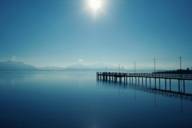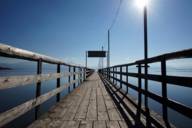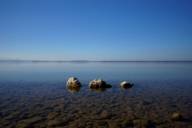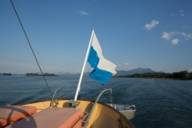
The Chiemsee is one of the most popular excursion destinations in the Munich region. And that's no wonder, because at Bavaria's largest lake, you can not only do water sports, relax at the beach or take a bike tour, but also experience a lot of culture from Seeon Monastery to Schloss Herrenchiemsee.
- The Chiemsee at a glance: Sights & things to know
- Swimming at the Chiemsee: Beaches & swimming spots
- Herrenchiemsee Palace, Fraueninsel & Seeon Monastery
- Circumnavigating the Chiemsee: By bike or bus
- Travelling to the Chiemsee: How to get there from Munich
The Chiemsee is one of the most popular destinations in the Munich region. With an area of about 80 km² and a depth of 73 meters, it is not only the largest lake in Bavaria and the third largest in Germany, but also one of the cleanest swimming lakes. The lake was created about 10,000 years ago, towards the end of the Ice Age. Originating from the earlier glaciers, there are still many smaller lakes, rivers and moors in the area, especially in the southern and northern part of the Chiemsee – such as near Eggstätt-Hemhofer lake plain, one of the oldest nature reserves in Bavaria, or Kendlmühlfilze high moor.
The majority of the Chiemsee shoreline is natural, but there are also numerous lidos, bathing spots and villages. The most famous are Prien am Chiemsee, Seeon, Bernau, Übersee and Chieming. Water sports enthusiasts also like to gather at the beautiful lake in the Chiemgau Alps, as they can go sailing, rent stand-up paddles, do kayaking or canoeing, kiteboarding, surfing, or even rafting on the Tiroler Ache (river). Ashore, too, there is a lot to be explored – the lake has a circumference of 64 kilometres and can easily be circumnavigated by bike or on foot.

What makes the Chiemsee so special: In addition to beautiful nature and a variety of water sports, the popular destination boasts a wide cultural offering. Herrenchiemsee Palace, also known as "little Versailles”, is located on Herreninsel, one of two islands on the lake that can be visited year-round. In its immediate neighbourhood is the smaller Fraueninsel with the Frauenwörth Monastery. Both destinations can be conveniently reached by boat. In winter, when the ice on the lake is thick enough, you can even walk to the islands.
And in summer, the lake is a magnet for swimming fans – after all, it's not called "the Bavarian Sea" for nothing. For one thing, the water here is of consistently high quality, and for another, the Chiemsee is pleasantly warm: Between June and September, the lake has an average temperature of between 20 and 23 degrees, while, in the hot season, the water temperature can rise to 26 degrees. Not least because of its good water quality, the lake has been under nature protection since 1954, as many endangered bird species breed here. Swimming is allowed at the designated bathing areas and beaches – such as the beach at Chieming, Bernau, Breitbrunn, Seebruck, Gollenshausen, the Beach Bar in Übersee or the numerous public bathing spots.

If you go to the Chiemsee, you definitely should not miss Herrenchiemsee Palace: The magnificent building was commissioned by King Ludwig II and modelled on Versailles – as was the palace garden, which was planned by the court garden director Carl von Effner. Regrettably, the Bavarian "Kini" only resided here for about ten days, before he died in an accident at Starnberger See (lake) in the summer of 1886. Today, visitors can admire the magnificent interiors on a guided tour. Highlights in the castle include the Hall of Mirrors, the marble staircase and "Tischlein deck dich," a retractable dining table. Herreninsel is the largest island on the Chiemsee and can only be reached by ship or boat. These run regularly and with direct connections from Prien am Chiemsee (15 minutes) and Bernau (23 minutes).

If you feel like visiting Fraueninsel afterwards, you can ferry across in just ten minutes. The small neighbouring island has its very unique charm: One of the main attractions on the car- and bike-free island is the pilgrimage site Kloster Frauenwörth, the oldest nunnery in Germany. Here, you can sit comfortably in the beautiful beer garden, explore the island on a walk or visit the Christkindlmarkt in winter.
Another very famous site is monastery Seeon a few kilometres north of the Chiemsee. The former Benedictine abbey is now used as a cultural and educational centre of the district of Upper Bavaria and a conference hotel. Furthermore, it regularly hosts cultural events such as concerts, exhibitions and readings. On a guided tour, you can gain an insight into the Benedictine monastery at your leisure.
Sporty cyclists or e-bike fans choose the almost 60-kilometre Chiemsee cycle path, which leads along unpaved roads, asphalt cycle tracks and side roads. The path not only follows part of the shoreline, but is also one of the most beautiful cycle paths in Bavaria with great viewpoints overlooking the Herreninsel and Fraueninsel islands or the mountains. If that's not enough, you can also take a multi-day tour around the region or opt for a road bike route. The Chiemsee circular route, a cycle path running directly along the water, requires a more leisurely pace, as this tour is shared with pedestrians at times. Chiemseeringlinie, a bus that circles the lake several times a day, offers barrier-free travel.

If you want to travel to the Chiemsee by car, take the A8 highway in the direction of Salzburg. It usually takes about an hour to get to Prien. The road that passes close to the southern Chiemsee is particularly beautiful. A more sustainable and convenient alternative is to travel by train with Deutsche Bahn or Meridian: This way, you can reach Prien in less than an hour and then continue by boat, bus, bike, the Chiemsee train or on foot. For a day trip with a maximum of five people, the Bayern Ticket or the Guten Tag Ticket are worthwhile.
Train connection: about 1 hour to Prien. More information under bahn.de
Car: about 1 hour to Prien via the A8 motorway